10/03/2025 – 13/03/2025
Day 1 – Katowice
In February I saw a €19,- airplane ticket from Eindhoven to Katowice and I had to buy it. I’ve been trying to travel more freely, op de bonnefooi, we would call it in Dutch. I always plan my trips months in advance, which is fun, but sometimes I just want to get up and go. After the success of my trip to Germany last summer, I thought: why not try it again? I’ve gotten pretty good at packing everything into my military surplus backpack which just about fits into the dimensions for a personal item on Wizz Air (not Ryanair though…). My trip would be 4 days and take me from Katowice back to The Netherlands by train, after having flown there I thought that would be the more sustainable thing to do.
Katowice airport is in the middle of nowhere but it does have a new railway station. The connections however are diabolical. A few local lines run an extremely irregular service to the nearby towns of no regional importance, the closest you can get is Bytom or Gliwice which are both miles away from the city of Katowice where I wanted to go. Luckily I met some people on a forum who directed me to the M19 bus which runs through farmers fields and tiny villages for an hour to reach the city of Sosnowiec (still not Katowice) where I can transfer to another bus. This 220 bus takes me to the first transit peculiarity I want to visit, tram line 27.
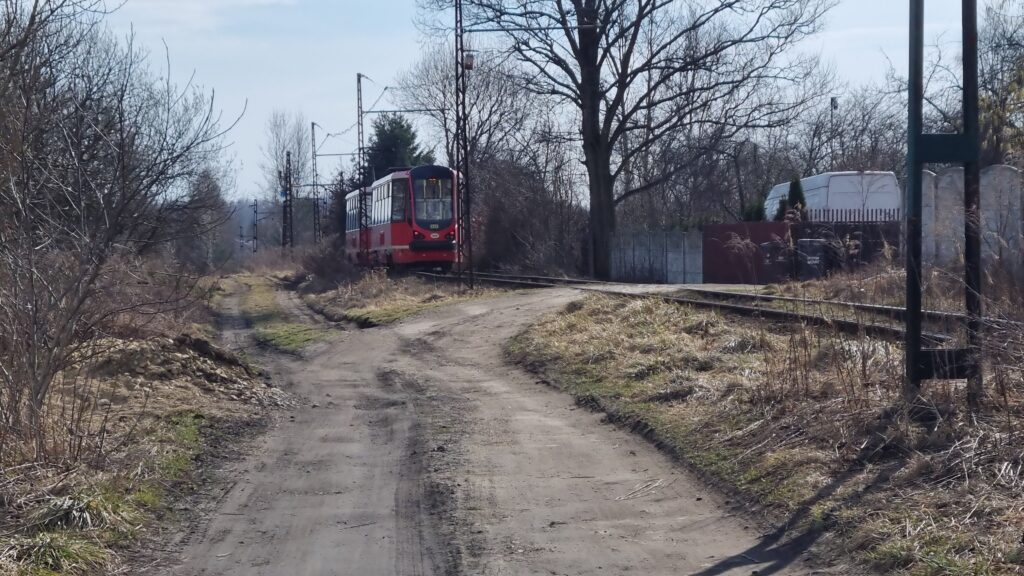
Line 27 runs from Kazimierz Górniczy Pętla to Sosnowiec and beyond. In the Eastern outskirts it runs on one of the most wonderful parts of tram tracks I have ever ridden on although they did shake me up quite a bit. Most of the section is single-tracked with passing points at the tram stops. On the Kornela Makuszyńskiego street (the names will only get harder to pronounce) the line runs basically through the front gardens of the residents as it crosses numerous driveways and it feels like this is a real, old-school, tram interurban like most European cities used to have (and some still have e.g. in Switzerland).
All trams and most buses in the metro area are run by ZTM. They have a red colour scheme and come in all shapes and sizes. Most really old Tatra’s have now been phased out, but a few modernised ones still run on the system. As is often the case with tram systems in the former Warsaw Pact countries, the individual lines do not run very often, but extreme interlining give some good frequencies on trunk routes. This interlining is partly due to how many direct routes are present in the system. Some examples of this include Kryvy Rih, Vinnitsia and Vitebsk. This does mean that on the branches the headways are often not great. They’re okay, similar to what we are used to in The Netherlands (10-15 minutes), but nothing to write home about.
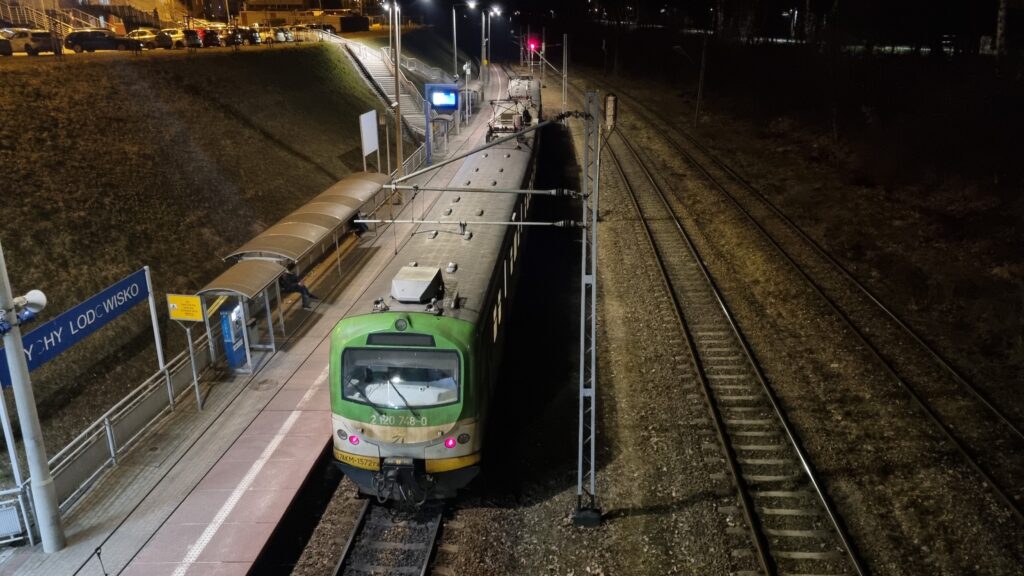
After having settled into my delightful 1960s apartment, I take a regional train to the nearby town of Tychy, 20 minutes south of Katowice. When coming to Poland I hoped to find some old trainsets rolling around but that was far from the truth (sad for me, good for accessibility and normal passengers). Poland has been upgrading their fleet intensely and most trains seems to be from the last 20 years. I did hear about some refurbished EN57’s running on the Tychy line so I had to try them. Sadly the refurb made them look nothing like the old EN57’s, oh well, the sound was the same at least.
Looking at Tychy from above it is clear that the majority of this town was designed under the communist ideals of town building. Plattenbau surrounded by wide roads and green parks. The spine of the town has an extension of the railway with 4 stops until it reached the terminus which is conveniently located close to an American style diner. The food was okay but the burger was loaded too full. Burger taller than wide is no good. Tychy however has one of the only 3 remaining trolleybus networks in Poland. With pre-planned arterial roads like Tychy has, running a gridded systems of trolleybuses makes a lot of sense and after riding it for a few minutes, it was time to go back to Katowice.
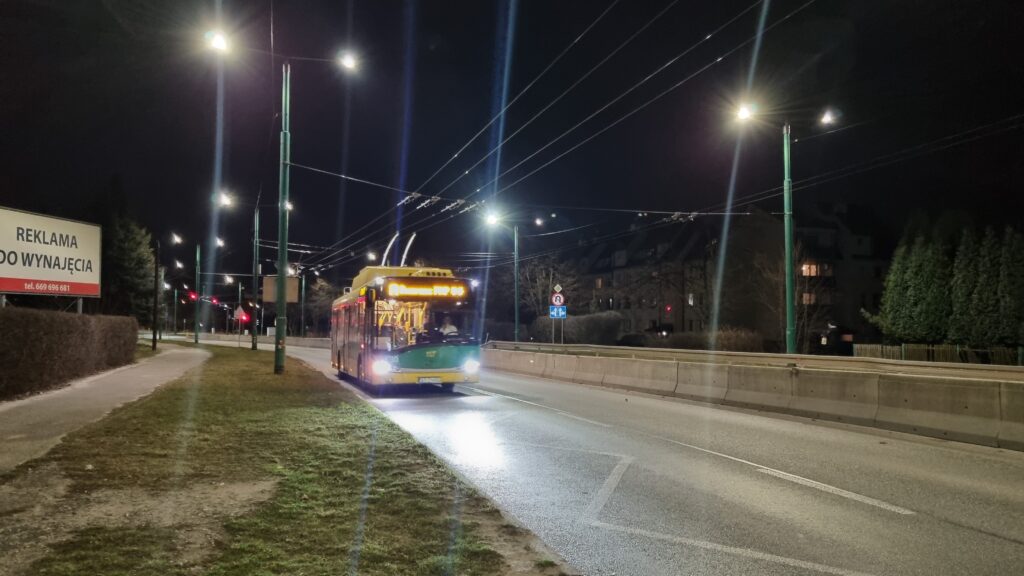
Day 2 – Katowice and Wrocław
I have wanted to visit the Katowice region ever since I found out about the extensive interurban tram network which stretches out around 40km wide across the entire, very industrial, metro area. Katowice itself is a very functional city and not very human scale, as is often the case with these Eastern European post-war parts of the city. But there are some nice walkable areas near the train station and a large square with a wide boulevard leading to the imposing concert hall. On this square is a set of public elevators (you won’t miss them) which take you up to a bowling & billiards club but are also awesome for getting a free view of Katowice from up high.
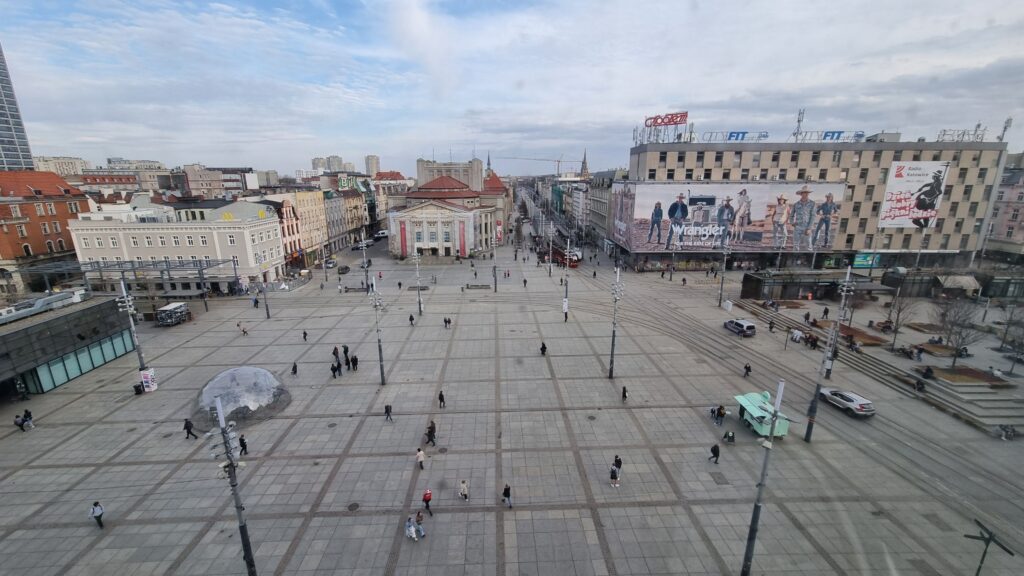
Now it’s time for me to visit the location I have had pinned on Google Maps for a long time, a single track tram crossing of a freight line at an abandoned steel mill. The vibes on Streetview were just too East-bloc to pass by. To get here I take line 7 from Katowice past the city of Chorzów and into the town of Świętochłowice. I hope the size of the network is finally starting to dawn on you, we are passing through multiple cities on one tram line. At Świętochłowice Mijanka I change onto line 9 which turns out to be another one of my favourite lines of this system. Once I get around to writing the “ride guide” page of my website this will definitely be on there. Line 9 snakes through suburbs and villages which have been absorbed by the Upper Silesian metro area. The elevation changes make for some nice views into the coal-mining heartland that made this region so industrial.
As we wind through suburb after suburb, tower block after tower block, we finally end up in the town of Nowy Bytom, New Bytom. This town is home to one of the many steel mills in the region but this one, like many others, is shutting down. Probably due to cheaper production costs in lower-wage countries whose population is now forced to bear the physical health costs of industrial steel factories. The factory workers didn’t seem to happy about the closure either as there were some protest banners outside the factory entrance.
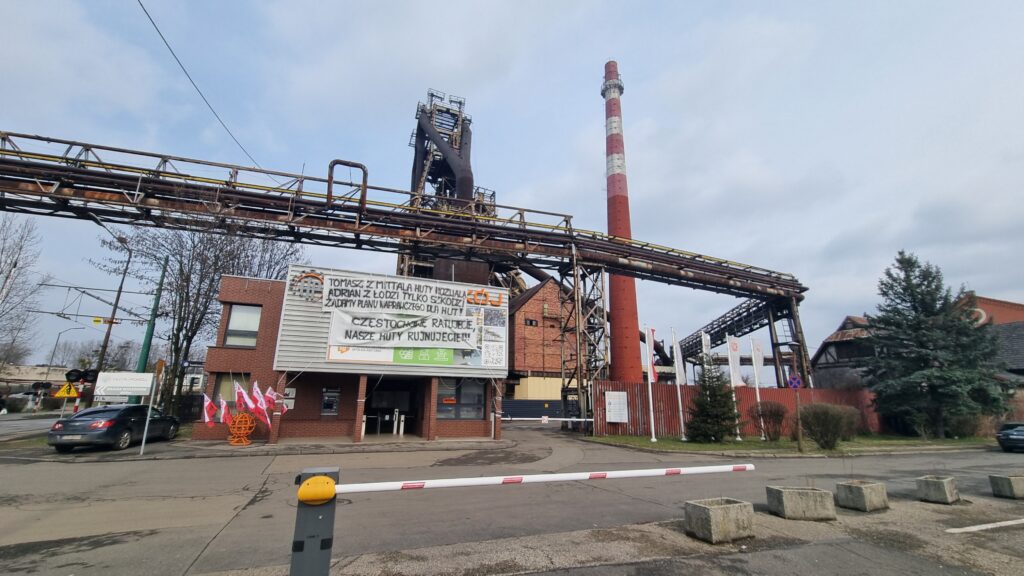
Tram line 9 runs straight through the steel mill on a narrow road with tall fences on either side. This makes for an amazing industrial backdrop for the bright red one car tram to ride by on a single track section. It turns out I’m not great at taking pictures so you’ll have to do with one where a car passes in front of the tram. Trams run here every 20 minutes so I had to wait a long time for a tram to pass.
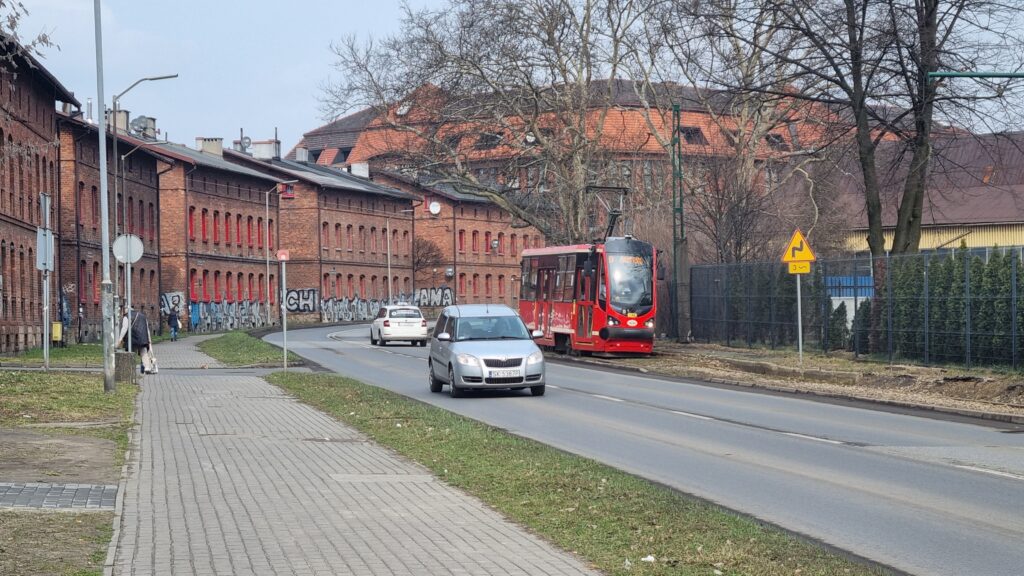
North of the steel works I get on the tram again and took it one stop to the crazy terminal/interchange of Chebzie Pętla where lines 1, 9, 11 & 17 meet. I rush to the waiting tram 1 which takes me westward in the direction of Zabrze. Halfway I get out at the mining museum “Sztolnia Królowa Luiza“, one of many in the area. It is quiet with no tourists around but everything is operating as usual so I take a look around. One of the buildings has a working, huge steam engine that was used to haul the workers and coal up and down the mineshaft. Every hour someone comes to operate it and it is mighty! The two steam engines turn a wheel which is connected to the elevators in the mineshaft. The operator has a sign showing the current location of the two elevators and can control the speed and braking of whole system. There is plenty more to see at this museum, but there is also a small military museum nearby so I visit that too.
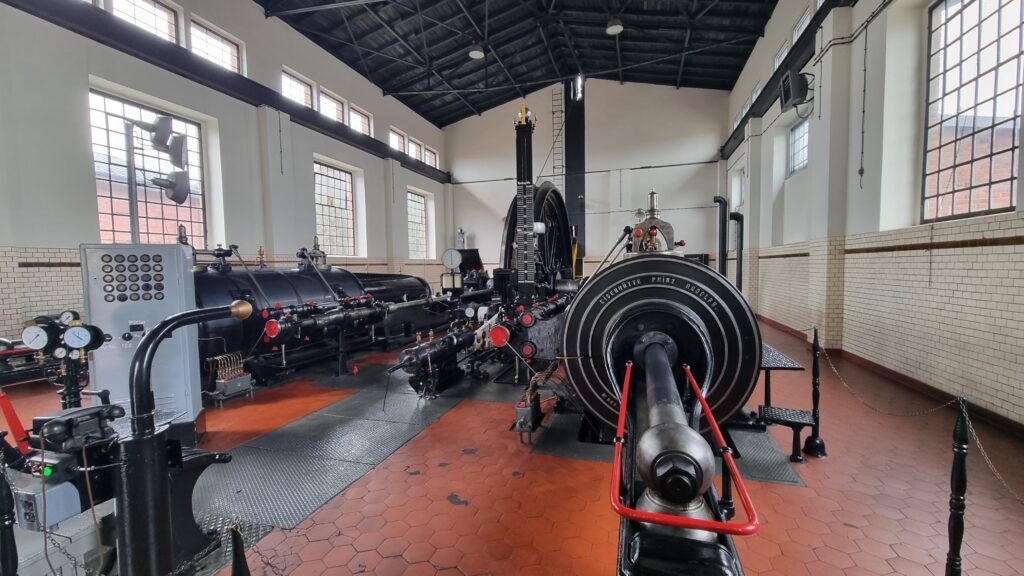
Tram 1 takes me all the way to Zabrze now and I’m here far too early. I have booked an advance ticket on the train to Wrocław in the evening but it’s currently 14h00. I could stay here and do some more lines, I heard line 3 from Zabrze to the south is great and if I go to Bytom in the North I can ride the strange line 38 which was run with very old tram car from 1949 until very recently. But I didn’t plan much time to see Wrocław and I do want to have a look around there so I buy a second ticket and hop on the earliest Intercity train. Tickets are quite cheap here, this 02h07m journey cost me less than €6,-.
Intercity trains in Poland are run by PKP and some of them have dining cars in the consist and let me tell you, they are amazing. If you are ever in Poland, take an intercity train and check if it has a WARS dining car using vagonweb, a great website for train information in a bunch of European countries. If your train has a carriage with a red stripe then you have a dining car. The menu is quite extensive and very Polish. Pierogi, grilled chicken and pork chops are the main courses I could choose from and there are plenty of soups, sandwiches, salads and breakfast options also available. I chose the grilled chicken and a local beer. And when they say grilled chicken, they mean it. A tiny woman and a huge guy were standing in the kitchen and grilling my chicken on an actual stove! Not a microwave meal or something put into an oven, no they actually cooked it on the spot. I got some nice potatoes and cabbage with it and my chicken was smothered in pesto sauce. Total price including beer? 58PLN or around €13, well worth it.
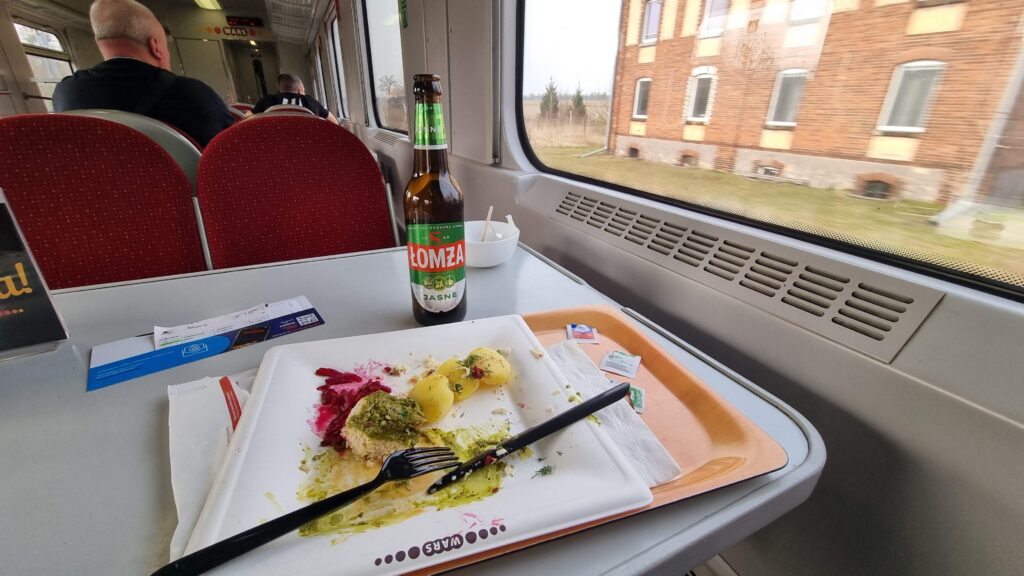
My journey takes me through the city of Opole and the Polish countryside which I enjoy from the dining car for the entire journey. As we roll into Wrocław it’s around 16h30 and I spotted a miniature train exhibition a short tram ride away. It’s located in the tallest tower in the city and cost too much to get in in my opinion. For the same price you can see Miniatur Wunderland which is leagues more impressive. It was still fun to see though. Now it’s time to find my hotel which is located a 15 minute walk from the city centre.
Day 3 – Wrocław, Wolsztyn and Poznań
Wrocław is a wonderful city with a very nice and quite large historic centre flanked on the northern edge by the Oder river. In the river are a few islands on which a few parks and neighbourhoods have been built. I didn’t expect the city to be this pleasant to visit and if I knew I would have planned more time here! The square has a weird block of buildings right in the middle which is skewed ever so slightly which makes it look out of place, especially when looking at it from above.
I start the day by walking through a little less appealing part of town where they bulldozed a bunch of buildings to make a large car and tram interchange. I need to pass this though to get to the southern river bank near the university. Yesterday I found out there is a very strange little gondola over the river which connects the two parts of the university campus which have been unfortunately split by the river. There is no useful bridge nearby so they decided to build a gondola which opened in 2013. It was built by Doppelmayr Garaventa and it does look like it belongs in a ski resort or in a mountainous South American city. As a child I always had the dream to work for Doppelmayr and it was one of the reasons I chose Civil Engineering as my degree. There is something off about this gondola though. although they use the regular 15 person cars that you usually see on looping cable cars, there are only two cars on the system. This is because they operate it like an aerial tramway with two cars travelling back and forth instead of a closed loop that is always turning. This drastically decreases the capacity as the ride takes 2 minutes and if you add the boarding times and the 15 person capacity, the total maximum capacity is only 366 people per hour. Compare this to the capacity of a revolving system like those found in La Paz which have capacities of around 3000 p/h/d.
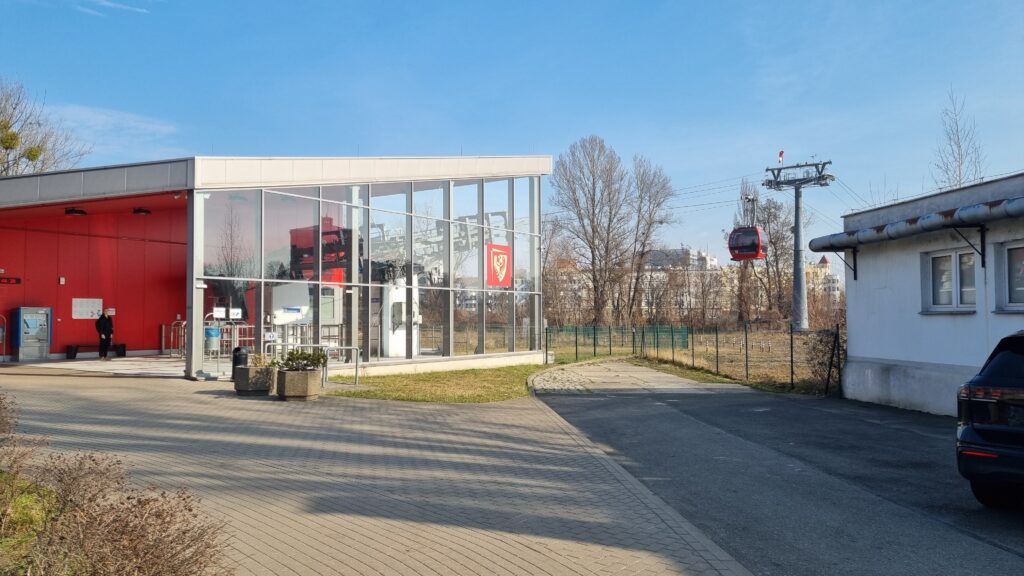
Using the cable car is free for staff and students but I have to buy a ticket, a single is 3PLN or €0,70. The ride is very short but pleasant as it takes us over the river with a nice view of the university and the buildings on the embankment. I do wonder why they didn’t just build a pedestrian bridge as it wouldn’t need a high vertical clearance or moving section as the other nearby bridges are low fixed spans anyway. It might have cost a little more initially (although I wouldn’t expect it to cost too much more than this cable car), and the maintenance costs have to be lower than this system. It’s a nice novelty though.
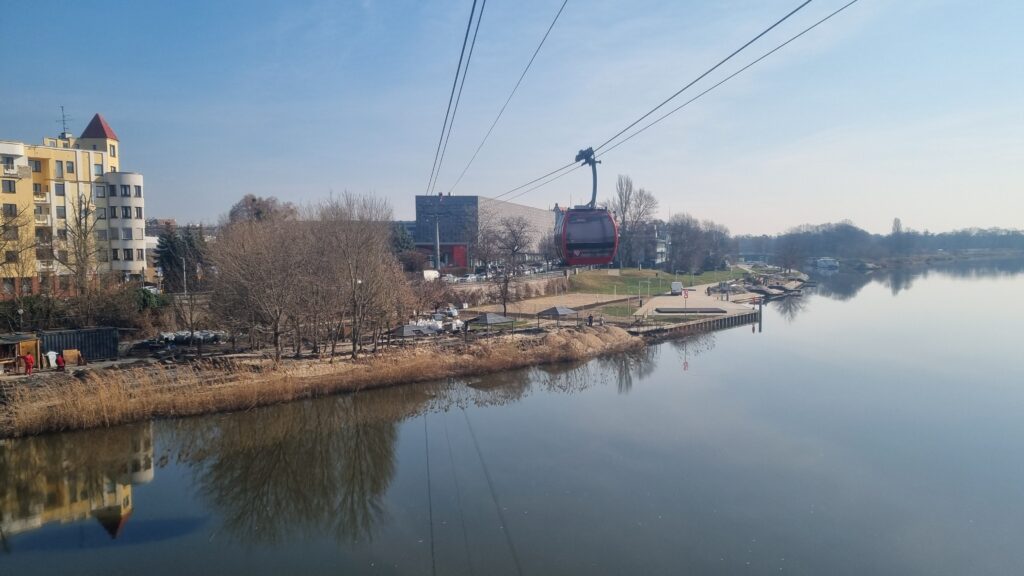
As I walk around the north bank I’m greeted by some lovely old architecture and a cathedral. If I had had more time to spend here I definitely would have. Sadly I have a train to catch in about 30 minutes and my maps app says it’s a 30 minute walk so I have to pick up the pace. I cross the Tumski bridge onto another island in the river and I spot a very quaint transit location where a very narrow road with two tram tracks winds it way through some historic buildings and over an old bridge with grace. If I was good at photography and had more time this would be a lovely place to shoot some transit geeky pictures.
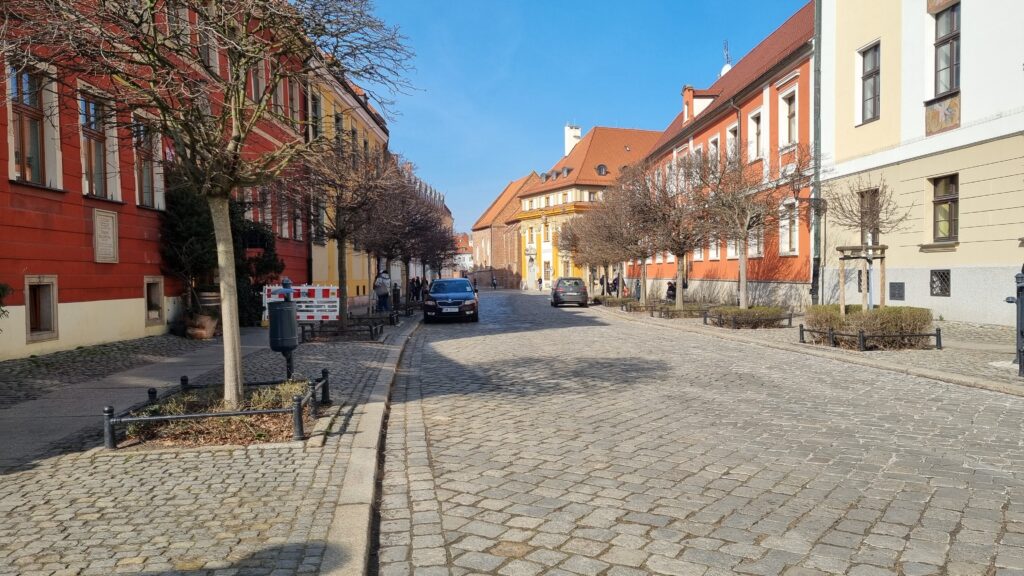
To make sure I catch my train I do something I haven’t done before, use an e-scooter. These are banned in The Netherlands (and in general I think that’s a good thing, but that’s a discussion for another time) but I did want to try them out here. I have the Uber app and I can easily unlock one of the scooters. My 30 minute walk has now turned into a 10 minute ride mostly on sidewalks as the bicycle infrastructure is sub-par. At the train station I can only park the scooter at the designated areas which I think is a good step to reducing the littering of them around the city. I had a lecture from Anne Brown and she talked about her research into micromobility parking clutter and people’s perception of it, I recommend reading her research here.
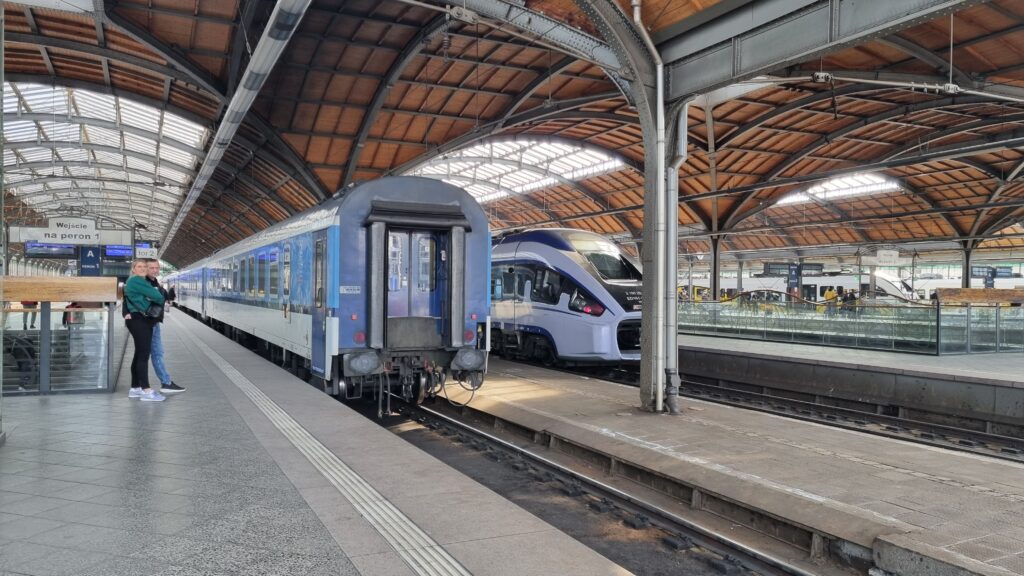
I get to the main station with plenty of time to spare and can see the locomotive of my train get changed just before we leave for Leszno, our next destination. I am in another Intercity train with a WARS dining car so I go there and enjoy a breakfast whilst seeing the countryside pass me by. Once in Leszno, a desolate station with a very modern (and ugly) new station building, I get off and wait for my connecting train to Wolsztyn. I once came across an article about the last remaining scheduled steam trains in Europe which operated on the line from Wolsztyn to Zbąszynek and sometimes to Leszno. It’s really just a heritage steam group that takes over one of the scheduled daily services to run it with steam instead of diesel trains, but it’s fun nonetheless as you don’t need a special heritage ticket as your normal train ticket will do just fine.
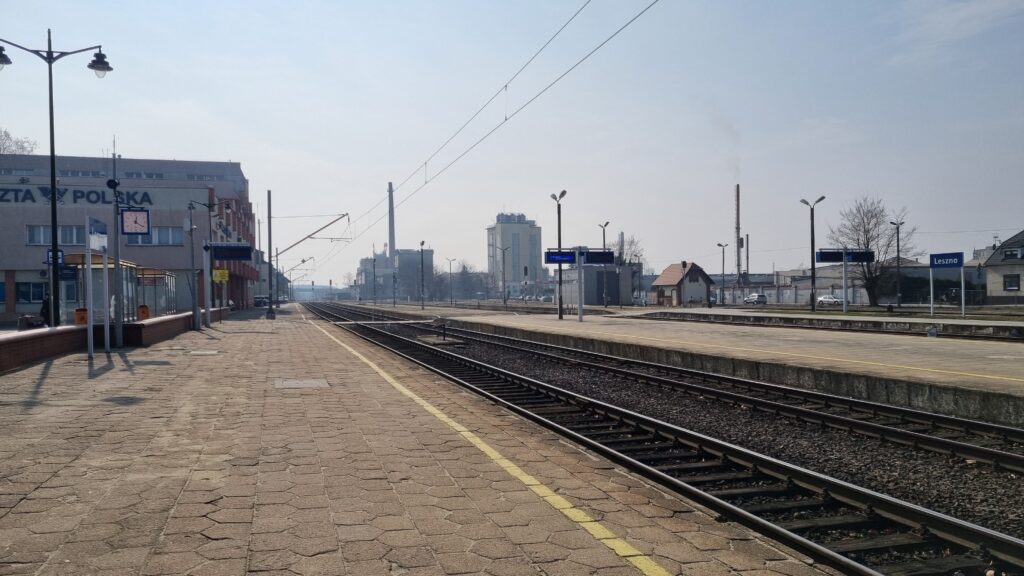
Sadly I just got the news that, due to concession problems (???), the steam trains are not operating this month and the service will be replaced by a regular diesel train. I still want to go to Wolsztyn to see the steam operations though, even if they aren’t operating with passengers. It’s a nice ride and takes around an hour before we enter Wolsztyn station which is a 10 minute walk away from the steam train museum. Entry is around €5,- and you are free to roam around the very active train yard with a working turntable and plenty of steam action going on. After 5 minutes a small dumptruck drives onto the terrain and starts dumping at least 1000kg of coal, a reminder of why we don’t use steam trains anymore. The museum is very pleasant and you are free to walk around anywhere and get very close to all the equipment with the slow puffing of a shunting engine in the background.
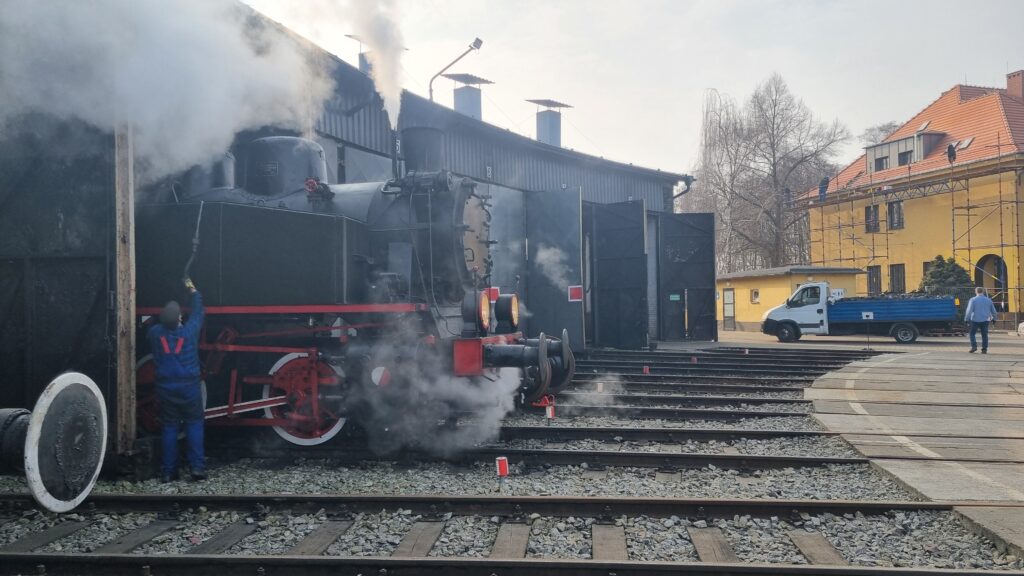
With the original plan now sabotaged I decide to head to Poznan instead Zbąszynek. I’ve visited Poznan before and it’s another wonderful old city with massive suburbs developed after the war. To the North is a suburb built completely out of huge apartment blocks and the central spine has a light rail line running through it to connect the thousands of people living here to the centre of Poznan. I take the tram up to the suburb, walk around a little bit and take a circuitous bus back to my hotel. I hadn’t had the staple food of Poland, Pierogi, yet so that is what I had for dinner here. Time to go to bed as my train leaves early tomorrow morning.
Day 4 – Berlin
The Berlin-Warszawa-Express is a 5x daily international EuroCity train connecting the capitals of Germany and Poland. The largest city on the route besides the capitals is Poznan where I get on at 07h32 in the morning. The station of Poznan is plagued with a case of “constant announcement disease“. For a period of 10 minutes I timed how long the longest announcement silence was and it was 14 seconds. Every train was announced including the train length, class locations, and delay all in Polish. Once in the train I made my way to my favourite place as fast as possible, the WARS dining car, where I had my breakfast of two eggs, some bread and a coffee. Cost around €6,-.
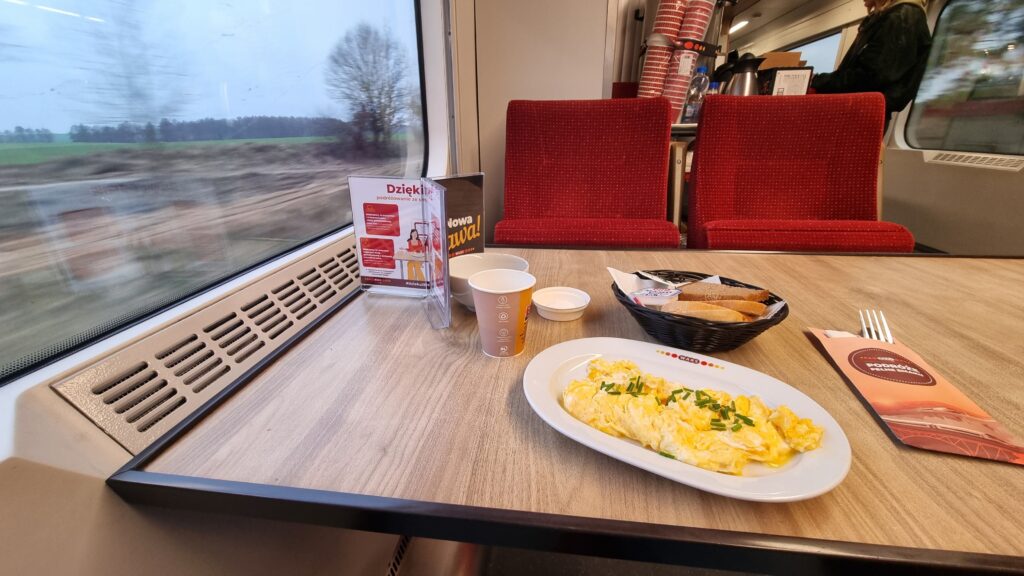
The ride takes 4 hours and crosses the border at Frankfurt (not the one you’re thinking of). I was expecting border patrol to enter and check me due to the useless and harmful border checks that most Shengen countries have reinstated to “curb illegal immigration”. This didn’t happen and we were fast back on our way to Berlin. On the way we did pass the Tesla gigafactory where I took the opportunity to show our wannabe king’s jester a finger which is roughly in the middle of all the other fingers. The Berlin-Warszawa-Express terminates at the impressive Berlin Hauptbahnhof after passing on one of my favourite pieces of train track in the entire world, the viaduct going straight through the heart of Berlin.
A few years ago Berlin opened the connecting part of the U5 line which now takes passengers from the Hauptbahnhof to sights such as the Brandenburger Tor, Museumsinsel and Alexanderplatz. The stations are very impressive with Museumsinsel being the cherry on top. It has a beautiful dark blue vaulted ceiling with LEDs mimicking a starry sky.
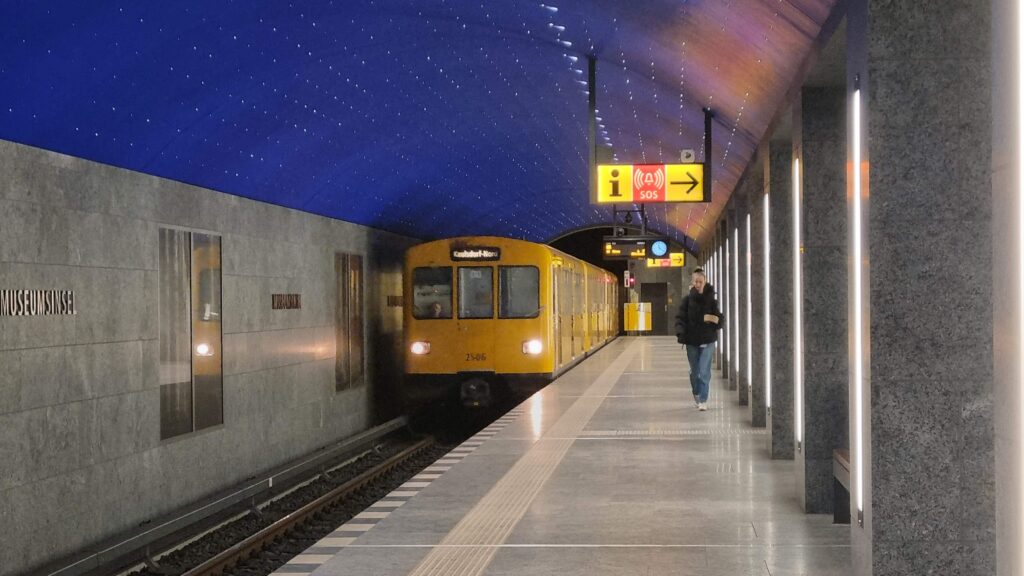
I’ve visited Berlin many times but hadn’t gone out to the Eastern suburbs yet which is the plan for today. There are two remaining tram lines here that disconnected from the rest of the tram network and connect the nearby villages of Woltersdorf, Schöneiche and Rüdersdorf to the S-Bahn system. There is also a third tram a little more to the North which runs to Strausberg but I didn’t have time to go there. Next time though as they have a ferry here that runs on overhead wired electricity.
From the S-Bahn station Rahnsdorf which is seemingly in the middle of nowhere I walk to the only building nearby which is a waiting shelter for the Woltersdorf Straßenbahn. This 5.6km long line runs mostly on single tracks and spends about 1/3 of its track length in a forest. After emerging from the woods it winds it way through the streets of Woltersdorf to end at the locks. About a year ago they replaced the quaint Gotha trams from the 50s-60s with a very modern Moderus Gamma tram which looks hideous. It has become step free since this upgrade. The ride is smooth and at the end I double-back and alight at the village centre. Here the bus takes me North to the town of Rüdersdorf where I have lunch at a restaurant run by a lovely Ukrainian family, they are very interested in the Ukrainian flag I have sown onto my backpack. I have to disappoint them with my lack of Ukrainian language skills.
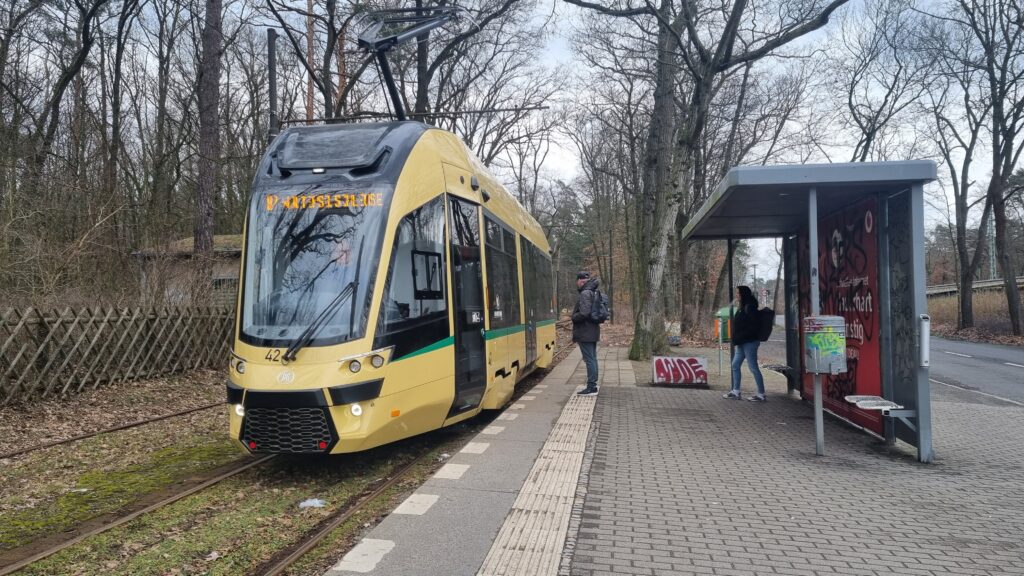
The Rüdersdorf tramway operates a mixture of vehicles with some old Tatra’s from Cottbus, eight old Duewag M6s from Mülheim and Heidelberg and some newer Skoda’s they got from Helsinki, some of my favourite looking trams with a great paint scheme. We however get the most rickety tram I’ve ridden, and that says a lot having just come from Katowice. The ride is very shaky, very loud but very enjoyable. The tracks definitely need a rebuild as they seemed to be the largest factor for the ride quality. This tram also takes us through a forest to end up at the Friedrichshagen S-Bahn station.
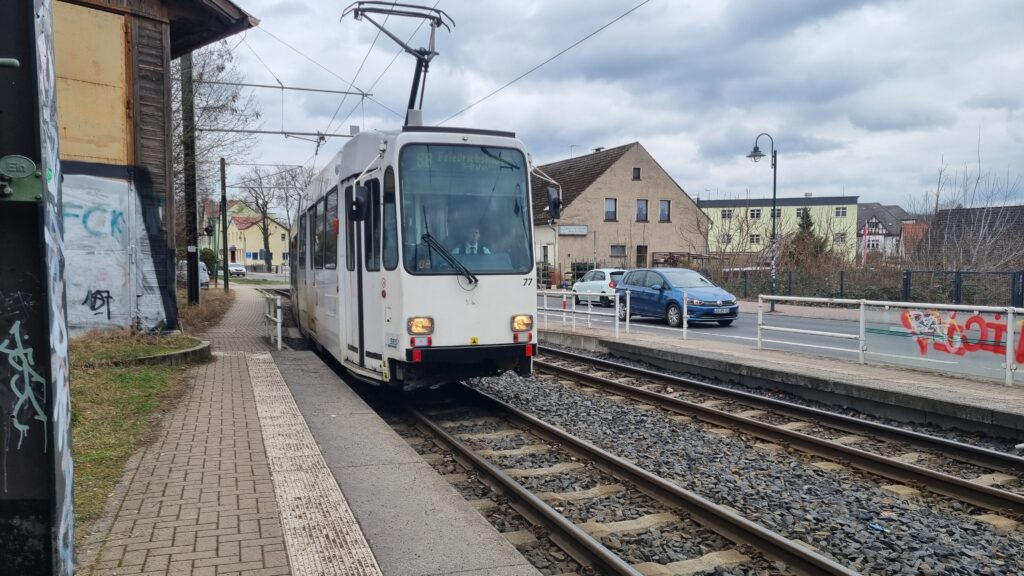
My train back home leaves from Berlin Gesundbrunnen, not the Hauptbahnhof sadly and with only about an hour before departure I make my way there. I do take a detour to ride the old elevated section of U-Bahn through Friedrichshain and change at the Kottbusser Tor station to take the U8 straight to Gesundbrunnen. Our NS hauled DB carriages roll in on time and before we leave I already get an email that we will be delayed, classic Intercity Amsterdam-Berlin. After 15 minutes we leave and our trip to The Netherlands goes smoothly. I arrive back home with a total delay of 30 minutes.
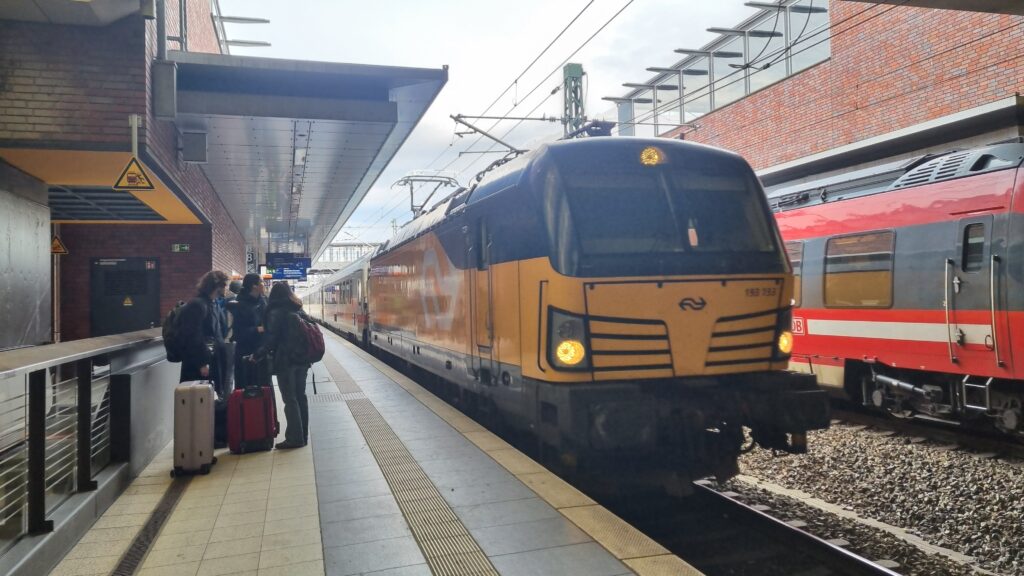
This trip was a lot of fun. I had a very calm quarter so I could afford to take some time off to make this unexpected trip. I had wanted to visit Katowice for a long time and I am happy that I did before they start closing or altering the interurban system. My favourite parts of the trip were the times I spent in the WARS dining car which I recommend everyone to do at least once.
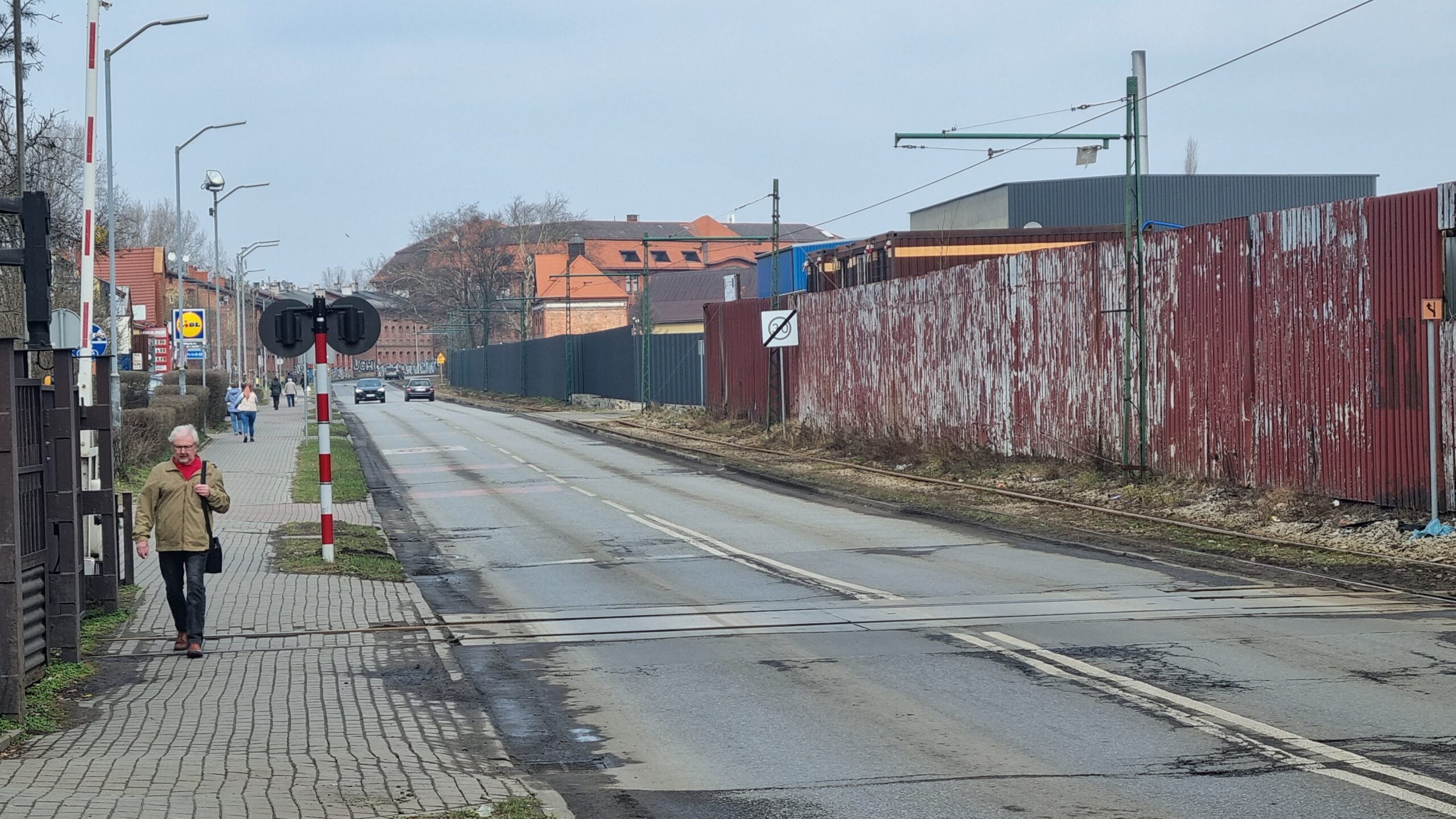
Leave a Reply